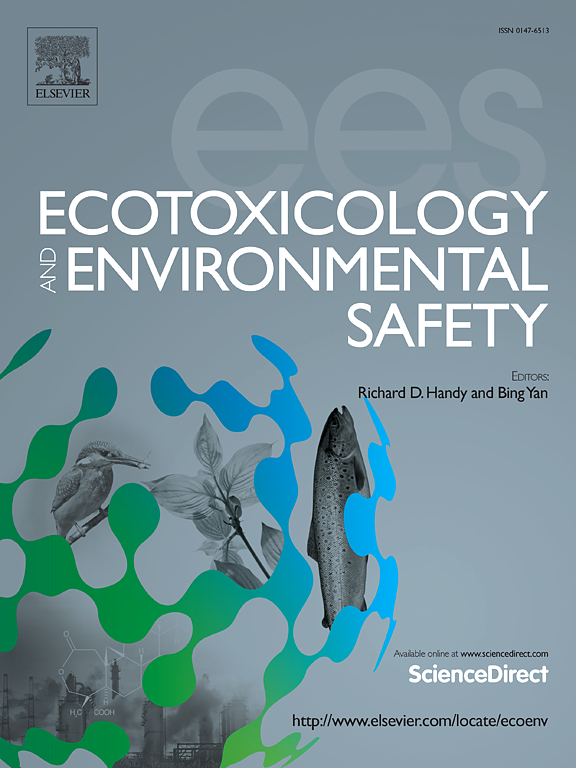温度升高如何影响双酚 A 对卵隐杆线虫及其消费者大型蚤的毒性?
IF 6.2
2区 环境科学与生态学
Q1 ENVIRONMENTAL SCIENCES
引用次数: 0
摘要
全球塑料产量的增加导致大量塑料沉积在水生生态系统中,并在塑料降解过程中释放出化学物质。其中,双酚 A(BPA)因其干扰内分泌的作用和广泛存在于水生环境中而成为全球关注的焦点。此外,双酚 A 对水生生物的毒性可受温度等全球变化胁迫因素的调节,而温度在生物的新陈代谢(包括有毒化合物的降解和积累)中起着至关重要的作用。在这项研究中,我们旨在了解温度如何调节双酚 A 对浮游植物物种(卵形隐单胞菌)的毒性效应,以及这种效应如何转移到其食草性消费者(大型蚤)身上。为此,我们首先确定了 C. ovata 对双酚 A 梯度(0-10 毫克/升)的敏感性。随后,我们通过实验确定了温度的升高(+5ºC)如何改变双酚 A 对浮游植物的生理、新陈代谢和生长的毒性影响。最后,我们研究了这种影响如何通过食物转移到大型蚤的生长速度上。我们的结果表明,5 毫克双酚 A L-1 的双酚 A 对 C. ovata 有负面影响,影响其光合产物光系统 II、净初级生产量、呼吸作用和生长。温度越高,这种影响越明显。此外,以在双酚 A 和高温条件下生长的 C. ovata 为食,D. magna 的生长速度也会下降。我们的研究结果表明,高温会加速双酚 A 对食物网底层生物的毒性影响,这种影响会通过食物转移到更高的层次。本文章由计算机程序翻译,如有差异,请以英文原文为准。
How does increasing temperature affect the toxicity of bisphenol A on Cryptomonas ovata and its consumer Daphnia magna?
The global rise in plastic production has led to significant plastic deposition in aquatic ecosystems, releasing chemical compounds as plastics degrade. Among these, bisphenol A (BPA) is a major global concern due to its endocrine-disrupting effects and widespread presence in aquatic environments. Furthermore, the toxicity of BPA on aquatic organisms can be modulated by global change stressors such as temperature, which plays an essential role in the metabolism of organisms, including the degradation and accumulation of toxic compounds. In this study, we aimed to understand how temperature can modulate the toxic effect of BPA on a phytoplankton species (Cryptomonas ovata) and how this effect can be transferred to its herbivorous consumer (Daphnia magna). To do this, we first determined the sensitivity of C. ovata over a BPA gradient (0–10 mg L−1). Subsequently, we experimentally determined how the increase in temperature (+5ºC) could modify the toxic effect of BPA on the physiology, metabolism and growth of the phytoplankton. Finally, we investigated how this effect transferred to the growth rate of D. magna through food. Our results show a negative effect of BPA on C. ovata from 5 mg BPA L−1, affecting its photosynthetic yield of photosystem II, net primary production, respiration, and growth. This effect was accelerated when the temperature was higher. Additionally, the growth rate of D. magna also decreased when fed on C. ovata grown in the presence of BPA and high temperature. Our results indicate that high temperature can accelerate the toxic effects of BPA on organisms located at the base of the food web and this effect could be transferred to higher levels through food.
求助全文
通过发布文献求助,成功后即可免费获取论文全文。
去求助
来源期刊
CiteScore
12.10
自引率
5.90%
发文量
1234
审稿时长
88 days
期刊介绍:
Ecotoxicology and Environmental Safety is a multi-disciplinary journal that focuses on understanding the exposure and effects of environmental contamination on organisms including human health. The scope of the journal covers three main themes. The topics within these themes, indicated below, include (but are not limited to) the following: Ecotoxicology、Environmental Chemistry、Environmental Safety etc.

 求助内容:
求助内容: 应助结果提醒方式:
应助结果提醒方式:


